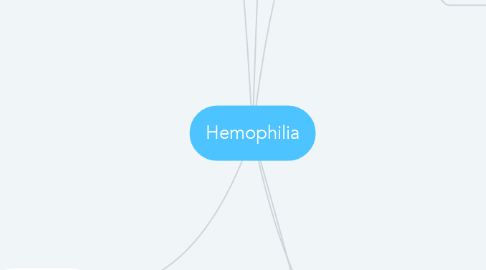
1. Treatment
1.1. Blood Factors
1.1.1. Injection of missing clotting factors based on disease type (Carson-DeWitt, 2018).
1.1.2. Blood transfusions may also be required in times of emergent low labs or excessive blood loss (Schub & Oji, 2018).
1.2. Medicine
1.2.1. Pain medication
1.2.2. Fibrin glue
1.2.3. Antifibrinolytics to reduce clot destruction (Schub & Oji, 2018).
1.2.4. Birth control for females
1.2.5. Immunosuppressive drugs to limit antibody production
1.2.6. Vitamin K ("Bleeding Disorders," 2019).
1.3. Immunization
1.3.1. Immunization for hepatitis is important due to frequent blood transfusions (Carson-DeWitt, 2018).
1.4. Bleeding Prevention
1.4.1. Gentle teeth care
1.4.2. Avoid cuts and scrapes
1.4.3. Avoid head injury
1.4.4. Refrain from blood thinning medications (Carson-DeWitt, 2018).
2. Assessment
2.1. Subjective
2.1.1. Painful joint movement, back pain, noticing more injuries, delayed clotting, fatigue (Schub & Oji, 2018).
2.2. Objective
2.2.1. Clinical Manifestations
2.2.1.1. Easily developed contusions
2.2.1.2. Hematuria
2.2.1.3. Hematesis
2.2.1.4. Profound bleeding
2.2.1.5. Hematochezia
2.2.1.6. Hematomas
2.2.1.7. Epistaxis
2.2.1.7.1. (Carson-DeWitt, 2018).
2.2.1.8. Pain and swelling in joints
2.2.1.9. Paralysis
2.2.1.10. Bleeding from gums
2.2.1.10.1. (Schub & Oji, 2018).
2.3. Focused Assessment
2.3.1. Hematomas on the extremities and/or torso, joint swelling, limited range of motion, or blood in urine or stool (Schub & Oji, 2018).
2.4. Diagnostics
2.4.1. Head or body CT, MRI, Angiograms, nucleotide bleeding scans, and X-rays (Schub & Oji, 2018).
2.5. Lab tests
2.5.1. Factor Assay testing, Bleeding studies, Polymerase chain reaction based of of DNA sampling from fetus (Schub & Oji, 2018).
2.6. Risk factors
2.6.1. Being male and having affected parents re the only real risk factors given the genetic nature (Carson-DeWitt, 2018).
3. Potential Complications
3.1. Excessive blood loss
3.2. Increased risk for intracranial hemorrhage
3.3. Aspirin and ibuprofen are contraindicated
3.4. Joint Damage
3.5. Infection risk
3.6. Adverse clotting factor reaction (Schub & Oji, 2018).
4. Etiology
4.1. There are two main types of hemophilia which are labeled as type A and B (Carson-DeWitt, 2018).
4.2. Type A bleeding disorder associated with factor VIII deficiency (Banasik & Copstead, 2019, p. 107).
4.2.1. Diagnosed with blood tests and a subjective history (Carson-DeWitt, 2018).
4.3. Type B is a deficiency of factor IX (Schub & Oji, 2018).
4.4. The factor deficiency is linked to only one copy of DNA being passed with a mutation. This is typically found in males for this reason but can be in females if passed from both parents (Carson-DeWitt, 2018).
5. Pathophysiology
5.1. Due to clotting factor deficiency, the blood does not clot as quickly or as effectively as the blood of the general population; although a platelet plug may form at the bleeding site, the clotting factor deficiency impairs formation of a stable fibrin clot (Schub & Oji, 2018).
6. Collaborative Care
6.1. Nursing interventions
6.1.1. Closely monitor vitals signs
6.1.2. Reduce risk of injury or bleeding
6.1.3. Administer medications
6.1.4. Assess for further pain or changes in symptoms or skin signs
6.1.5. Provide careful oral care
6.1.6. Provide emotional support and educate (Schub & Oji, 2018).
6.2. Planning Client Outcomes
6.2.1. Reduce bleeding and potential injury
6.2.2. Stabilize vital signs and regulate labs
6.2.3. Educate on avoidance techniques
6.2.4. Ability to complete ADL's and can care for self (Schub & Oji, 2018).
6.3. Care After Discharge
6.3.1. Educate patient and family on early signs and symptoms that may indicate an emergency
6.3.2. Emphasize seeking help and avoiding potential hazards
6.3.3. Teach gentle moth care, direct pressure for bleeding, and self-administration of clotting factors
6.3.4. Encourage use of medical alert bracelet with blood type
6.3.5. Refer for other specialist care (Schub & Oji, 2018).
6.4. Interdisciplinary Care
6.4.1. Communication between acute care team, genetic counseling, reproductive specialists, and the National Hemophilia Foundation for group care and education (Schub & Oji, 2018).

